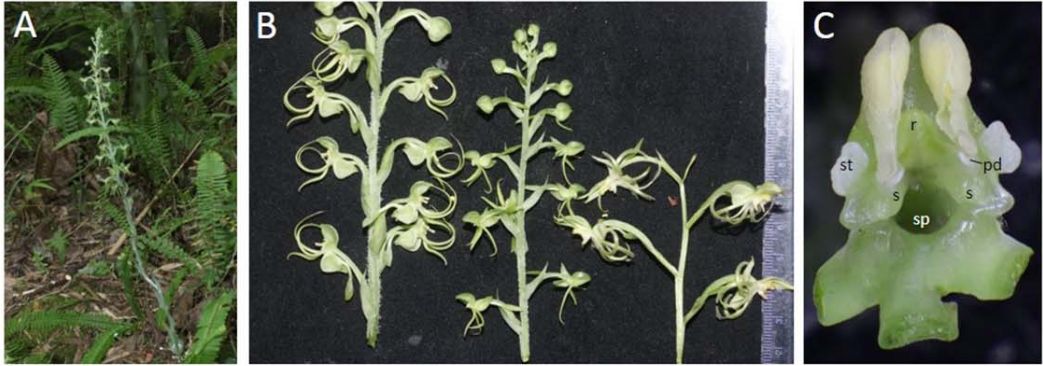

Habenaria alishanensis T.P.Lin & D.M.Huang 2017
A: Habenaria alishanensis in its native habitat. B: Three flowering Habenaria spp. in the type locality: H. ciliolaris (left), H. alishanensis (central), and H. petelotii (right). C: Front view of column of Habenaria alishanensis. r, rostellum; s, stigma; sp, spur; st, staminodes; pd, pollinia disc
Photos/drawing by © Tsan-Piao LIN, and Da-Ming HUANG

 LATER
LATER EARLY
EARLY
Common Name The Aishan Township Habenaria
Flower Size
Found in Taiwan in a bamboo stand at elevations around 700 meters as a large sized, warm growing terrestrial with 1 to 2, obliquely ellipsoid tubers giving rise to an erect, partially below ground stem with clustered on the lower half, 7 elliptic-lanceolate, obovate-spatulate, narrowly elliptic, glossy, smooth on the back with a keel like midvein leaves intergrading above into 11 bracts up the stem, that blooms in the later sumer and early fall on an erect, terminal, peduncle to 8.4" [21 cm] long, angled, covered by tiny cilate-pilose hairs along the angles, to 20" [50 cm] long overall, rachis to 11.2" [28 cm] long, many flowered inflorescence with ovate, shorter than the ovary floral bracts.
"The flowering time of H. petelotii and H. ciliolaris overlap with H. alishanensis (Fig. 1B). The senior author suspects that H. alishanensis T.P. Lin & D.M. Huang could be of hybrid origin. Habenaria ciliolaris could be a potential parent because it has a similar flower morphology with that of H. alishanensis but is much larger. However, the spreading tripartite labellum of H. alishanensis differs from that of H. ciliolaris and could be derived from another species. Habenaria stenopetala could be another potential parent because of the tripartite labellum, even though it is not very similar to that of H. alishanensis. Molecular tools must be used to investigate the potential parents. Habenaria alishanensis T.P. Lin & D.M. Huang is similar to H. leptoloba Benth. of Hong Kong (Barretto et al., 2011); however, it can be distinguished from H. leptoloba which has lanceolate or linear-lanceolate leaves, various much-smaller size measurements (for example, the flower is only .32" [8 mm] across), yellow lip, dorsal sepal ovate but not cucullate, cylindrical spur not showing significant dilation, anther locules widely separated, and the 2 lateral glands attached to the base of the rostellum but not forming short arms." Tsan-Piao LIN and Da-Ming HUANG 2017
Synonyms
References W3 Tropicos, Kew Monocot list , IPNI ;
* Newly discovered native orchids of Taiwan Tsan-Piao LIN and Da-Ming HUANG 2017 drawing/photo fide
--------------------------------------------------------------------------------------------------------------------------